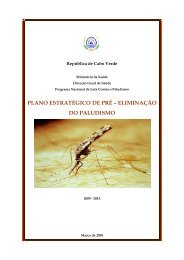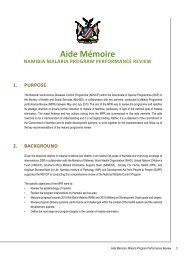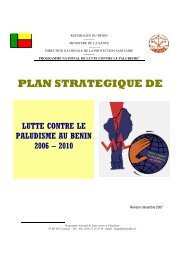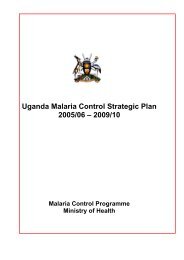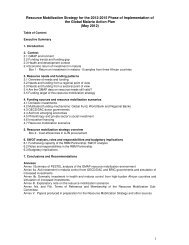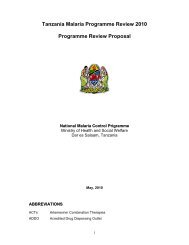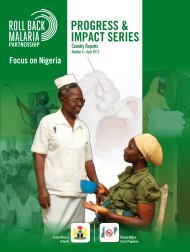Progress & ImPact serIes - Roll Back Malaria - World Health ...
Progress & ImPact serIes - Roll Back Malaria - World Health ...
Progress & ImPact serIes - Roll Back Malaria - World Health ...
You also want an ePaper? Increase the reach of your titles
YUMPU automatically turns print PDFs into web optimized ePapers that Google loves.
Public health services in the region generally<br />
aim to provide a parasite-based diagnosis using<br />
microscopy or RDTs and all countries with<br />
falciparum malaria have adopted ACTs. However,<br />
in Bangladesh, Cambodia, India, and Indonesia,<br />
more than half of fever cases are treated in the<br />
private sector, where the quality of diagnosis<br />
and treatment is variable. Since many of the<br />
populations most affected by malaria are located<br />
in areas not served by either public or private<br />
services, several countries have developed<br />
extensive programmes for community-based<br />
malaria diagnosis and treatment through<br />
volunteers in high-risk areas.<br />
Counterfeit and substandard antimalarial<br />
medicines including artesunate are in circulation<br />
throughout the Mekong subregion and the<br />
problem is more pronounced in border areas.<br />
National governments and WHO are cooperating<br />
with Interpol to take action against organized<br />
criminals involved in counterfeiting. In addition,<br />
oral artemisinin-based monotherapies are also<br />
widely available, which are thought to contribute<br />
to the emergence and spread of resistance to<br />
artesunate that was reported in 2009 on the<br />
Cambodia-Thailand border. A multinational<br />
containment effort has started, involving tight<br />
regulation and education of private sector<br />
providers, education of the public, intensification<br />
of preventive measures, and close surveillance<br />
of potential cases of drug resistance. More<br />
recently, WHO, together with <strong>Roll</strong> <strong>Back</strong> <strong>Malaria</strong>,<br />
launched the Global Plan for Artemisinin<br />
Resistance Containment to address and provide<br />
guidance on this public health threat.<br />
Resistance to the insecticides used to control<br />
mosquitoes is widespread, although vector<br />
control tools are currently effective in the vast<br />
majority of settings. In May 2012, WHO released<br />
the Global Plan for Insecticide Resistance<br />
Management, which outlines the pillars of action<br />
required to confront and overcome this threat,<br />
many of which are already being implemented<br />
(Box 3.3).<br />
Summary<br />
Several countries in the region have been<br />
successful in reducing malaria, partly due<br />
to increasing the coverage of antimalarial<br />
interventions but also because of development<br />
activities which have made habitats less suitable<br />
for malaria vectors. Despite some progress, the<br />
region still contains the highest numbers of<br />
cases and deaths from malaria outside of Africa.<br />
As malaria transmission has been controlled<br />
it is increasingly concentrated in populations<br />
and areas that have been least affected by<br />
development such as tribal populations and<br />
border areas, and where transmission can<br />
be particularly intense due to highly efficient<br />
vectors. Provision of services to these areas and<br />
populations presents particular challenges and<br />
requires more commitment and resources than<br />
in easier to reach populations. Yet it is in these<br />
areas that further efforts must be made in order<br />
to make significant inroads on the remaining<br />
burden of malaria outside of Africa and to prevent<br />
the emergence of drug resistance.<br />
DEFEATING MALARIA IN ASIA, THE PACIFIC, AMERICAS, MIDDLE EAST AND EuROPE<br />
45




